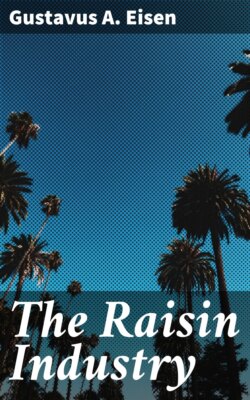Читать книгу The Raisin Industry - Gustavus A. Eisen - Страница 8
На сайте Литреса книга снята с продажи.
DEHESA RAISINS.
ОглавлениеTable of Contents
The finest or at least the most expensive brand of raisins made is the Dehesa raisin of Malaga. They are produced from the Muscatel variety and the name they bear has an interesting origin, giving us at the same time an insight in the development of the agricultural and horticultural resources of Spain. The word “Dehesa” is found by reference to a good Spanish dictionary to mean pasture ground. The “Dehesa” raisins then are pasture-ground raisins, or raisins grown on former pasture ground. The way the raisins came to be given such a name is as follows. Between the years 800 and the end of the fifteenth century, the fairest part of Spain as well as Portugal was occupied by the Moors. Contrary to their nature in other countries, they proved here extremely industrious, and excelled both as merchants, artisans and agriculturists. The waters of the streams were conducted to the land in aqueducts, dams were thrown across the rivers, reservoirs were formed, and the whole of Southern Spain became most highly cultivated, rich and prosperous. In fact, if the historians are to be believed, and the yet remaining views of former grandeur can be trusted, no country either in ancient or modern times has ever in prosperity rivaled the ancient Moorish kingdoms of Granada and Andalusia. In the thirteenth century the Christian knights and kings of Central and Northern Spain succeeded in conquering the Moors, who again were unmercifully expelled, massacred or enslaved, their cities burned and razed, and the fertile and cultivated districts utterly ruined. Vast tracts were depopulated and abandoned, and, nature taking its course, wild grass, shrubbery and trees soon covered the former highly cultivated plains. In the course of time these uncultivated lands attracted the attention of the highland shepherds, who drove their herds to them during the winters, again returning to the mountains at the advent of the dry season.
By degrees the self-taken rights of the sheepmen became more widely recognized, and, while the less valuable lands were taken possession of by the poorer peasantry, these pasture lands were set apart for the exclusive use of the sheep-owners. The pasture lands thus being free, it was no wonder that the sheep industry flourished, and that the flocks increased. The wool industry soon became one of the most important in Spain. The flocks were principally owned by nobles and monks, and the poor peasants, who constituted the only agricultural population, had very little if any chance to oppose the ever greater encroachments of the wandering flocks or their insolent owners. The Merinos, or moving sheep, were wintered in the warm valleys of Andalusia, Murcia and Estremadura, only to be again removed to the cooler mountains of Leon and Castille at the advent of spring. What curse this would entail on the agricultural population is easy to be seen. The sheep were moving in bands of 10,000 each, and 700 to 800 such flocks were moved annually twice through a country devoid of fences or inclosures of any kind. Numerous disputes and constant bloody fights arose between farmers and the shepherd, to settle which the “Council of the Mesta” was instituted. In tyranny, this dreaded institution was only equaled by the famous Inquisition, with which in birth and death it was almost contemporaneous. In the year 1556 a code of laws was promulgated, and a compromise was entered upon. But the tyranny of the shepherds, upheld through their “Mesta,” was in no way diminished. The latter continually extended its power, encroached upon new territory, appropriating gradually the finest pastures of Spain, and finally obtained a monopoly of the wool trade. Its tyranny became at last intolerable. The shepherds of the Mesta were more dreaded than robbers and highwaymen in every place through which they passed. Agriculture became almost impossible. At last the “Mesta” was abolished by the Cortez in Cadiz in 1812, and a few years afterwards the pastures or Dehesas were sold. One of the finest Dehesas near Velez, Malaga, was planted to Muscatel grapes, and through the combined fertility of the soil, and the abundance of moisture, the vineyard proved a great success. So fine were the grapes grown there that they attracted great attention; no such fine grapes had ever been seen in Andalusia before. The merchants to whom the first raisins were sold were much astonished, and wonderingly asked whence they came. The reply, “from the Dehesa,” was from that time on applied to the finest Muscatel grapes.
